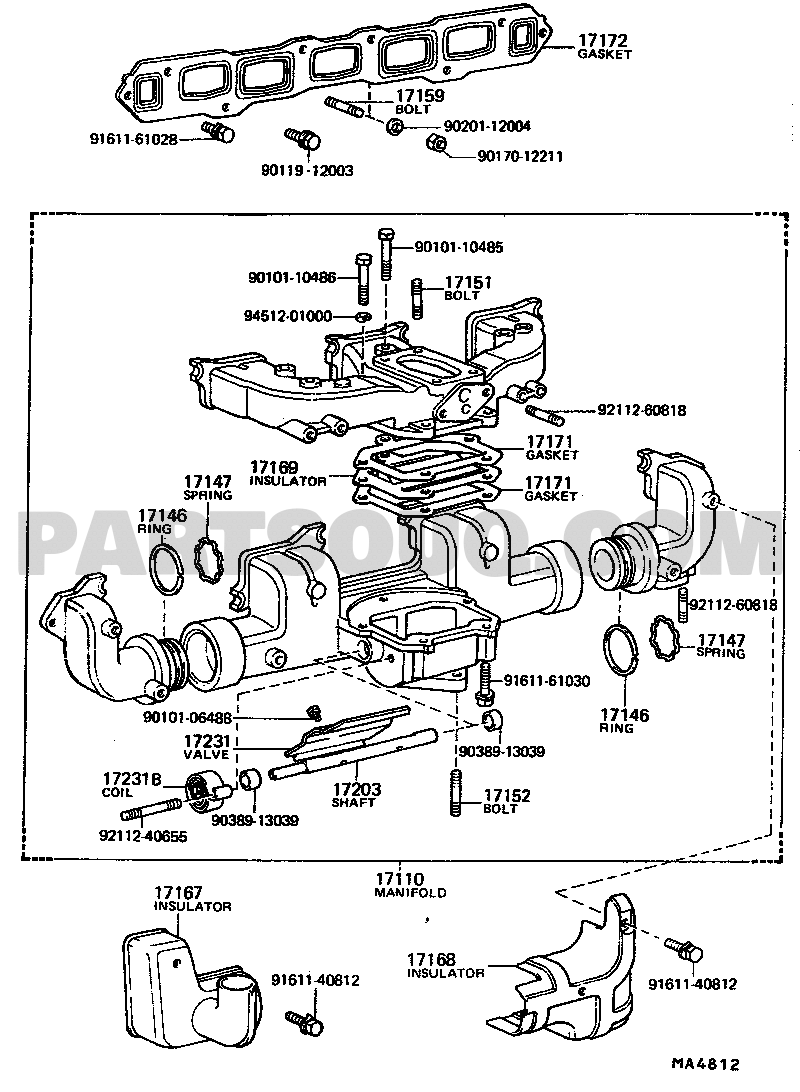Rusto
SILVER Star
I guess my question is - if the horns aren't leaking and it's not leaking where the intake and exhaust are mated, wouldn't it make sense just to leave together?
Follow along with the video below to see how to install our site as a web app on your home screen.
Note: This feature may not be available in some browsers.
This site may earn a commission from merchant affiliate
links, including eBay, Amazon, Skimlinks, and others.

I am rebuilding my exhaust/intake ...I see there are three bolts that come down from the top and two that come up from the bottom to hold the exhaust manifold to intake manifold/heat riser joint together. So I need (2) 90101-10486? and (1) 90101-10485? and ...85 doesn't get a cut washer? Looks like ...85 is NLA, can I use 3 of the ....86 bolts? I'm guessing that center bolt is a few mm longer than the other 2. Can someone give me the length of that bolt if they have a loose one. Also guessing it is 10mmx1.25

Super glue. I'm dead serious. It works a treat. Be generous. It burns off.I'm thinking about how to tack the horn joints so they don't move. Maybe a dab of pc11 or tacky 2 part epoxy on the joint...like a peas sized thick bead?
hmmm...after looking at this with the block off plate in position and the valve flipped. There is not going to be any movement of the valve by the spring. It is basically pinned in the hot and exhausing downward position by the block off plate. There is a 1/4 inch space between the manifold and the valve though so some air may move up here.so that the valve flap is flipped past the block off plate and the spring will close it the rest of the way when it heats up.
The flapper valve will be in the same "hot" position that it normally is in when the spring warms up and turns it. It will angle downward to deflect hot air coming out of the exhaust valves and upper part of the manifold to keep it moving downward. Removing it seems like it would make a pocket for the air to eddy around in and probably caused a change in the sound. Cruiser Outfitters block off plate is barely thicker than the isolator plate. And much thinner than the thickness of the valve.the flapper valve inside is just causing a restriction
For the long gasket at the head I sprayed all bolts and the two studs/nuts with liquid wrench for several days and they all came out without a problem. The last bolt closest to the firewall I turned with a 3/8 inch short socket plus swivel and stacked about 3 or 4 extensions to bring the ratchet out and over the brake booster. Couldn't get enough torque to break it loose. So went to short socket on the ratchet and tapped the end of the ratchet handle with a hammer to break it loose. Not sure how a torque wrench will work on this set up when putting it back though. For the forward most bolt I used a 3/8 inch drive socket because it was narrow and slipped past my saginaw ps pump. The rest I used 1/2 drive sockets and wrench. for the two at the bottom I stacked (2) three inch short extensions on a normal sized 17mm socket (not deep well) and it got the ratchet out past the manifolds.Wondering if I should change the intake/exhaust gasket myself
I have the Remflex gasket in hand, a backup intake manifold, the FSM and have read every thread about it here
There are a few ways to skin this cat. Most important is going about it in the right order. The manifold assembly is four parts as you know. First, the mating surface between the intake and exhaust has to be verified co-planar. Usually you can leave this alone because leaks here are not common. Second, the horns should be removed and the mounting surfaces where the horns slip into the exhaust manifold body cleaned, grooves cleaned, and the wavy springs and rings replaced. Third, the mating surfaces that interface with the head need to be verified co-planar. This is easiest to verify if you have access to a blanchard ground surface plate. Lay the assembled intake/exhaust manifold on the plate with this mating surface in contact. Using a flashlight from the opposite side look for gaps between the plate and the manifold. If you can see light creeping under the manifold check these points with feeler gauges to ensure they are within spec according to the FSM. This verification can be done with a good machinist straight edge in the absence of a surface plate but it is somewhat less reliable. In fact, that's what the FSM recommends.How did any of you re-surface the exhaust manifold at the riser?
I think I may not have actually answered your question. The riser at the front end of the exhaust pipe?How did any of you re-surface the exhaust manifold at the riser?
